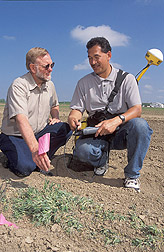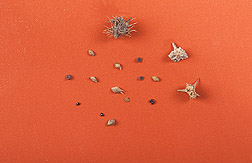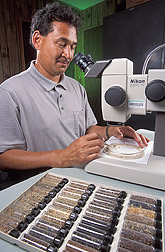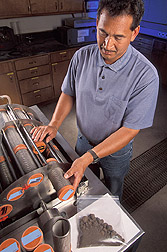Dealing With Those
|
|
 Plant physiologist Dale Shaner (left) and technician Douglass Barlin locate seed bank samples with GPS (global positioning system) coordinates so a map of the seed bank can be created. (K10640-1) |
You spend hours plucking each weed from your backyard garden. Then you spray some chemicals you bought from a local hardware store to make sure those pests don't reappear. Everything looks fine—until next year when even more weeds appear. Persistent weeds are a common problem for both the novice gardener and the professional farmer. When weed seeds fall, they form weed seed banks in the soil—"future weed problems waiting for you," according to Agricultural Research Service plant physiologist Lori J. Wiles. The goal of Wiles and other ARS scientists studying the ecology of weed seed banks is to help farmers find inexpensive, environmentally friendly ways to manage them. Unchecked, weeds will tap resources that crops need to produce profitable yields. |
 Weed seeds are identified by their size, shape, and color. Seeds of nine weed species are shown. (K10648-1) |
First, Find the Weeds Wiles's research focuses on the spatial distribution of weed seed banks. At the Water Management Research Laboratory in Fort Collins, Colorado, she takes soil samples to map locations of weed seed banks in a given field. Wiles found that the seed banks are distributed in a patchy manner, which can be both good and bad for the farmer, she says. Using the maps as a guide, farmers can treat just the weed patches with minimal amounts of the appropriate chemical. This so-called site-specific weed management can mean a 30- to 80-percent reduction in herbicide use, which saves the farmer money and benefits the environment. But it can take a lot of soil samples to get an accurate map—and that can be costly. Wiles says it costs $2.71 to identify and count the seeds in each 4-inch core sample. Wiles is now researching ways to make maps that will improve the farmer's bottom line. One key is to find out how many samples are really necessary to create an accurate weed map. Fortunately, the spatial distribution of weed seed banks is relatively stable, so farmers may have to create a map only every few years. Also, Wiles is putting the finishing touches on a software program—WEEDSITE—that helps growers investigate the value of site-specific management of weed seed banks and seedlings in cornfields. The program should be available soon. |
 Using a microscope, technician Douglass Barlin counts and identifies weed seeds extracted from soil samples. (K10644-1) |
Then, Customize Chemical Use Plant physiologist Dale L. Shaner, also of the Water Management Lab, looks specifically at herbicide use for weed seed banks. "We use only the amount of herbicide we need to get the job done," he says. Shaner studies and maps the electrical conductivity (EC) of cropland soil. Low EC indicates that an area contains lesser amounts of clay and organic matter. In such areas, herbicide binds loosely to soil particles, meaning less chemical can be used. (To learn more about EC maps, see Agricultural Research, December 2002.) Together, Shaner and Wiles hope to combine both types of maps into a system that would not only locate the seed banks, but also identify which chemicals are best to apply and in what amounts. Or . . . Put Weeds to Sleep At ARS' Red River Valley Agricultural Research Center in Fargo, North Dakota, Michael Foley, James V. Anderson, Dave Horvath, and Wun Chao are studying biologically based methods of fighting weeds. Their approach targets a physiological state known as dormancy, which affects weed seeds and root buds. The team's research complements that of Wiles and Shaner in that dormancy is key to the persistence of weed seed banks. |
 Technician Douglass Barlin extracts weed seeds with water from soil samples using an elutriator. (K10649-1) |
"Dormancy," explains Foley, who heads the center's Plant Sciences Research Unit, "is the inhibition of seed germination, even though the environmental conditions are suitable for the plant's growth." It's an evolutionary strategy to ensure weed and seed survival through periods of unfavorable conditions. Two weeds receiving attention are leafy spurge and wild oat. Foley says, "The roots of leafy spurge have little pink buds. If the plant's top is damaged, each root bud is capable of regenerating a new plant." This is one reason why leafy spurge is such a problem in rangelands of Montana, Wyoming, North Dakota, and South Dakota—states where the weed causes $120 million annually in economic losses. No less troublesome is wild oat, whose infiltration of cropland in North Dakota alone costs up to $200 million annually in yield losses and production costs. "Wild oat is mainly a problem in areas where small grains like barley and wheat are grown," Foley says. Its similarity to these crops limits herbicide use. With North Dakota State University professor Shakryar Kianian, Foley is using molecular genetics to identify DNA markers associated with the dormancy trait in wild oat seeds. So far, they've identified markers associated with three quantitative trait loci—large areas of chromosomes containing genes that influence quantitative traits such as dormancy. Having these markers narrows the scientists' search for dormancy genes during the next stage—gene cloning. "With cloned genes," Foley says, "it may be possible to find biochemical molecules they produce that stop or start seed dormancy in response to environmental cues." Meanwhile, Anderson, Horvath, and Chao are using DNA chip technology, also called microarrays, to observe gene activity in root buds of leafy spurge. The computer-assisted technique involves placing DNA from thousands of leafy spurge genes in individual spots on a single microscope slide. Complementary copies of RNA from root buds are then labeled with dye--red for growing buds and green for dormant ones. When placed on the slide, the labeled copies find and stick to the gene they came from. By comparing the amount of red and green on each gene, researchers can tell which genes are turned on or off when dormant buds begin to grow. This information could give rise to new, more effective herbicide formulations or—preferably—biologically based methods of weed control. For example, says Horvath, "If you can control dormancy genes, you can cause the plant to grow in the fall when it shouldn't or keep it from growing in the spring when it should. Then you're closer to developing a sustainable solution to the problem."—By David Elstein, and Jan Suszkiw, Agricultural Research Service Information Staff. This research is part of Soil Resource Management (#202) and Crop Protection and Quarantine (#304), two ARS National Programs described on the World Wide Web at http://www.ars.usda.gov/research/programs.htm. Lori J. Wiles and Dale L. Shaner are in the USDA-ARS Water Management Research Unit, 3317 West Vine Drive, Fort Collins, CO 80523; phone (970) 491-8511, fax (970) 491-8247. Michael E. Foley, James V. Anderson, Dave Horvath, and Wun Chao are in the USDA-ARS Plant Science Research Unit, 1605 Albrecht Blvd., Fargo, ND 58105; phone (701) 239-1250, fax (701) 239-1252. "Dealing With Those Pesky Weed Seed Banks" was published in the August 2003 issue of Agricultural Research magazine.
|






